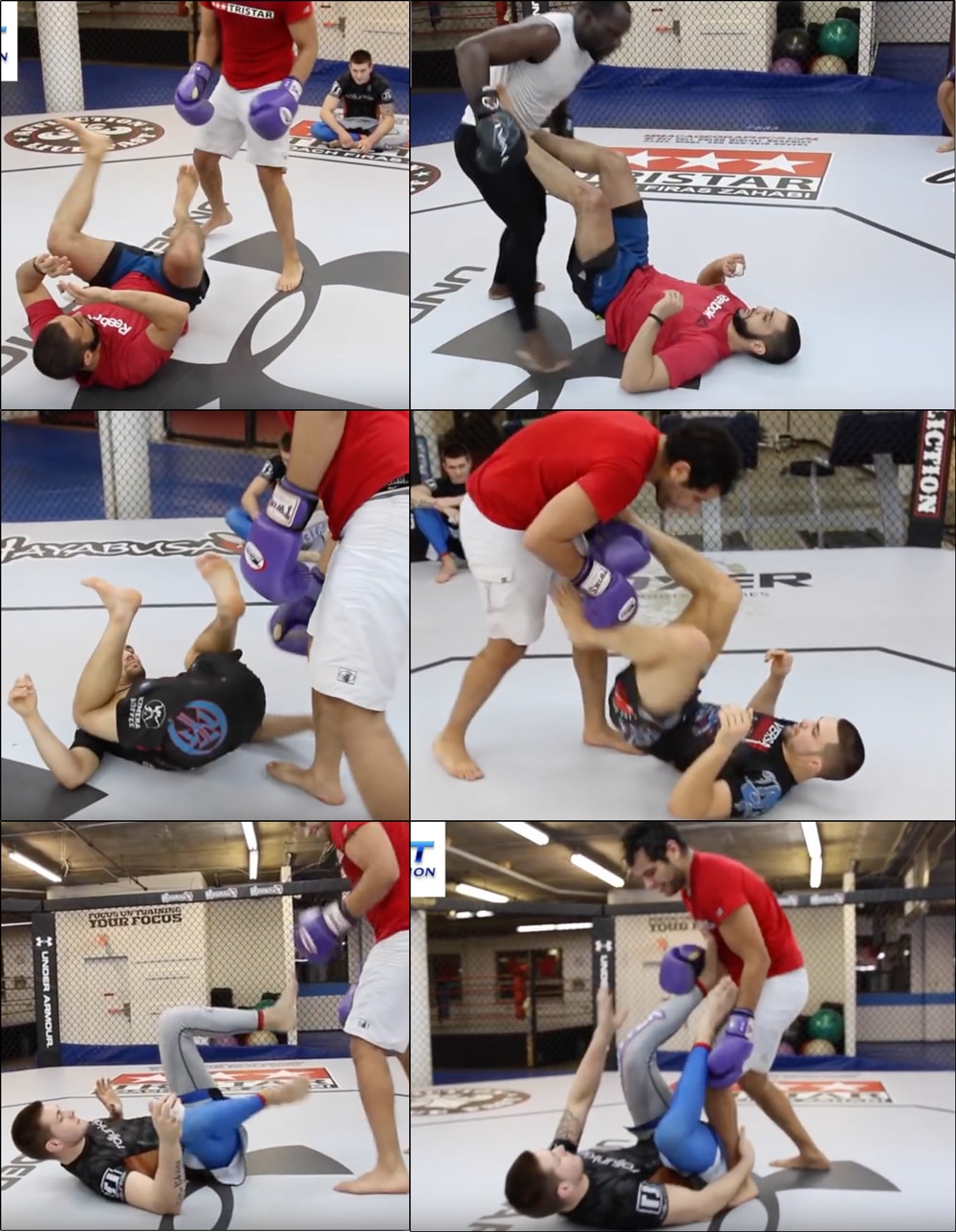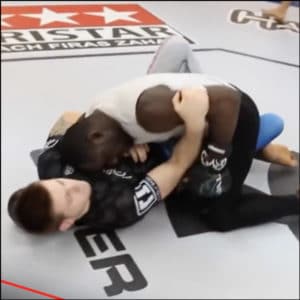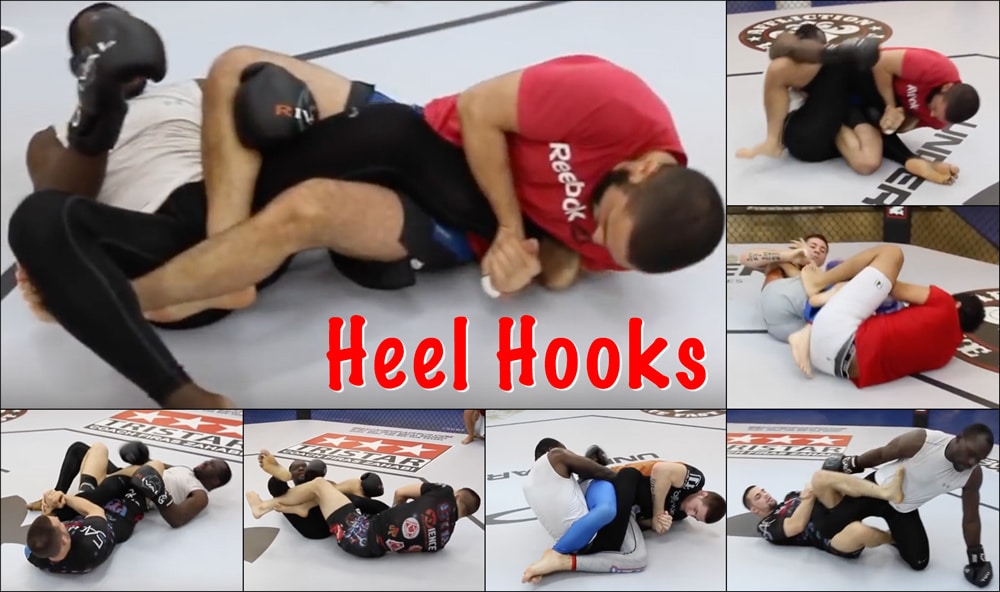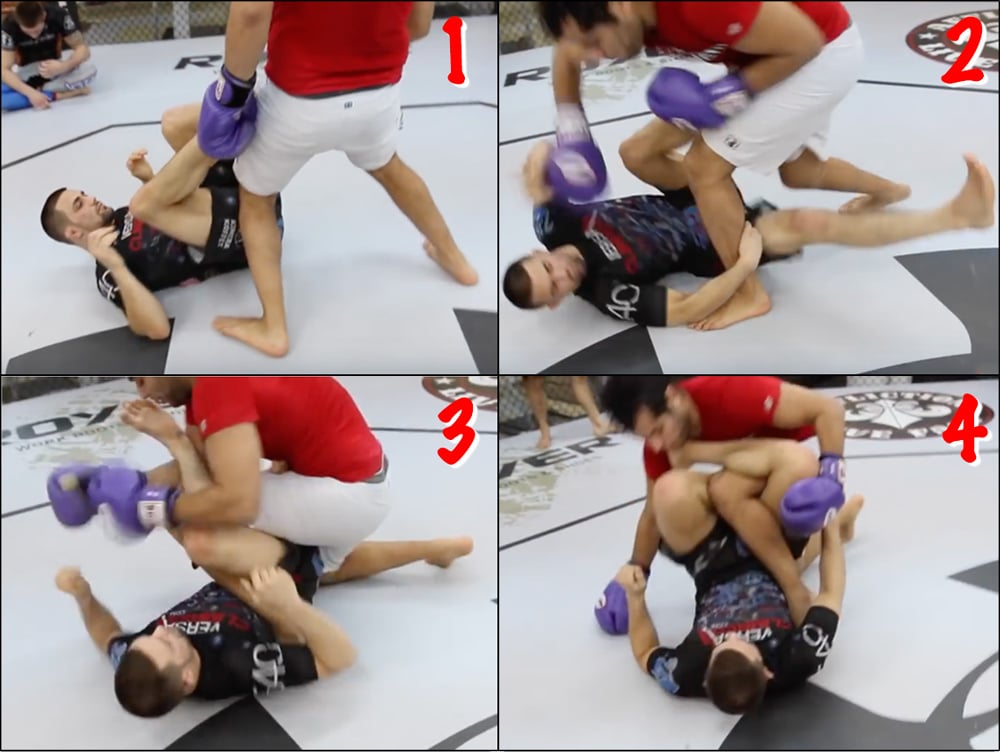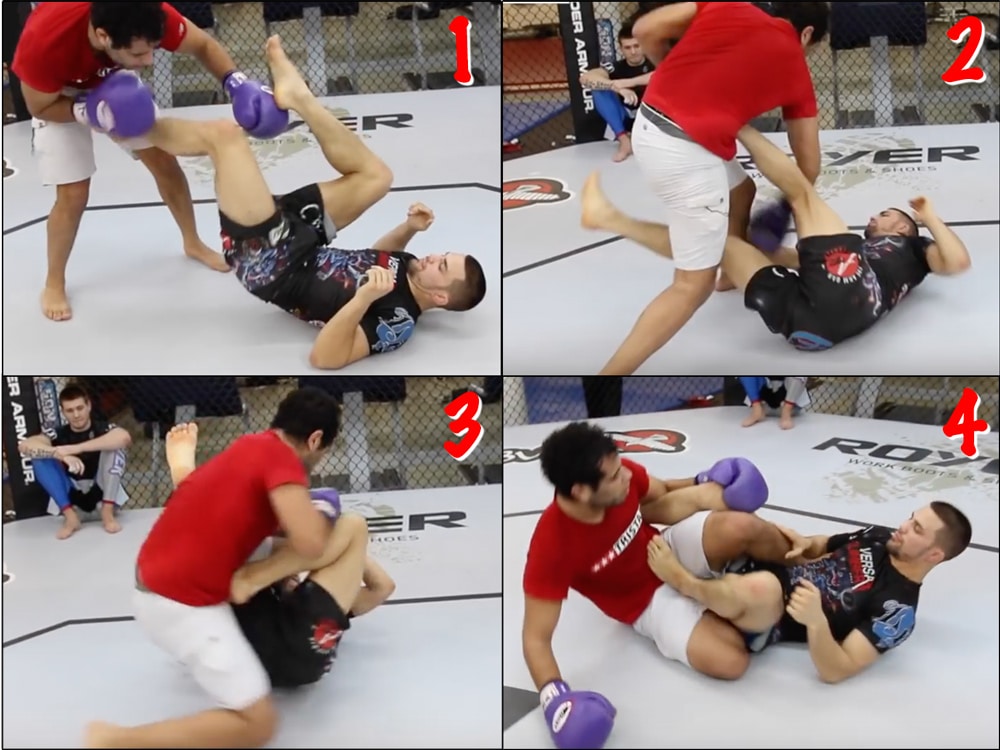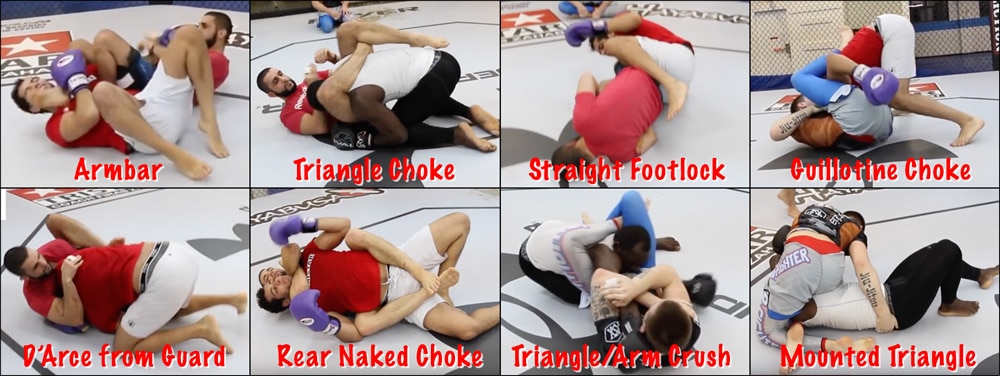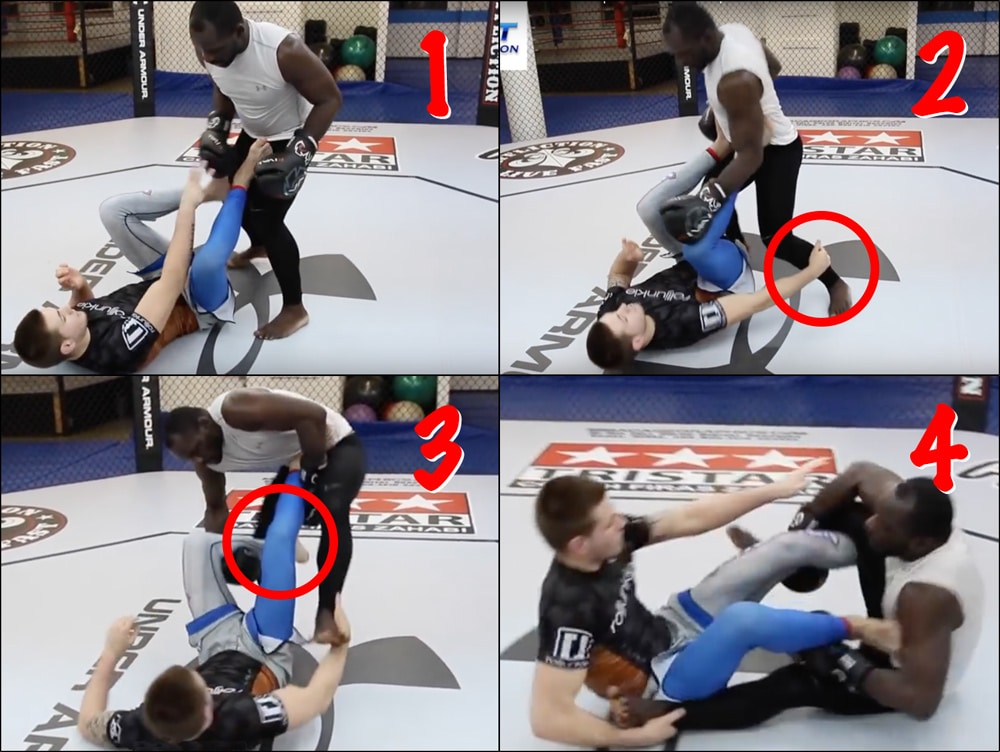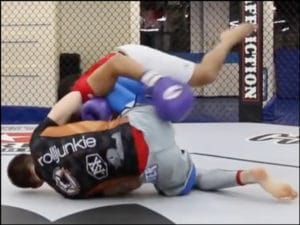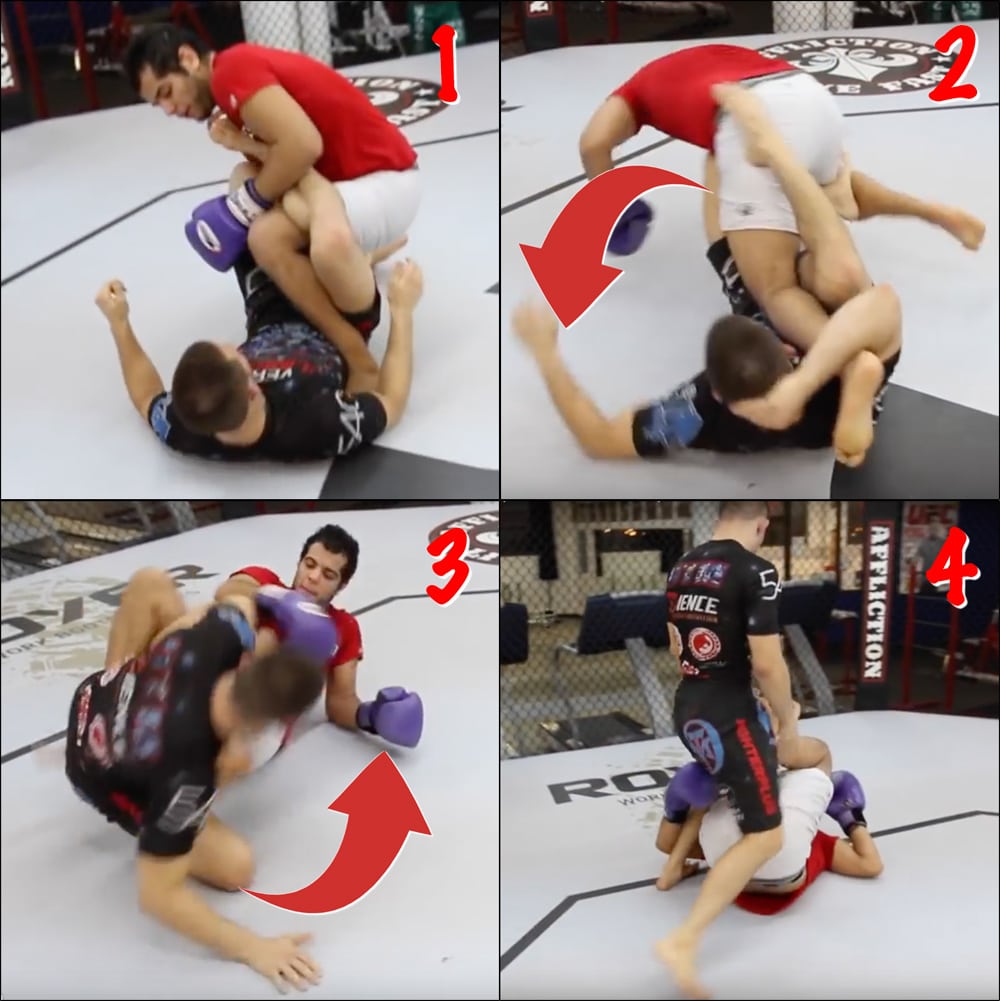Have you ever wondered if your BJJ would stand up in a self defense situation against an opponent determined to clean your clock with his fists?
By the end of this article I’m hoping you’ll have a much better idea of what to focus on to sharpen your BJJ skills for self defense purposes…
The self defense implications of grappling are important to me (click here to see my other posts on the topic) but today I want to write about one particularly cool video. And it’s not my video!
My friend and training partner Ritchie Yip recently sent me an email. All it said was “this is great” and then there was a link to click.
This brought me to a video called “MMA vs BJJ – Ground and Pound Experiment – Featuring 2 Special Guests” by MMA super-coach Firaz Zahabi.
(If you don’t know who Firaz is then shame on you! He’s a BJJ black belt, the former coach of Georges St. Pierre, and the one of the main instructors at Tristar Gym, an MMA powerhouse located in Montreal Quebec.)
Anyway the video in question starts with footage of an unfortunate BJJ practitioner getting pounded into the ground by a larger opponent. Firaz then asks what would happen if you took some MMA guys and put them on top of some grappling experts.
To help answer this questions he recruits two super-high level grapplers (Gordon Ryan and Garry Tonon) who have to defend themselves against punches and strikes from the bottom and try their best to survive, sweep and submit the top players.
What happens is VERY interesting!
You can see the video in its entirety right here; in the rest of the article I break down some of what happened and how you might incorporate these lessons into your own training…
Wasn’t that some cool footage?
Before we get into the nitty-gritty of the techniques and positions let’s debunk a couple of objections that I’m sure the naysayers will use…
Objection #1: “This isn’t a fair comparison – these are world class grapplers going against amateurs”
First of all, consider that the experts were put into a pretty bad position every time: on the bottom against a punching opponent. It’s not like they were starting out on top.
It’s relatively easy to win a fight from on top, especially if you’re a trained grappler. If you’re a blue belt and your opponent isn’t then if you end up on top you should be able to finish the fight, or at least completely control your opponent 99% of the time.
In an MMA or self defense context where strikes are allowed this becomes much harder. The laws of physics are against you, and to defy those odds you need to have a skill discrepancy to survive.
These guys were starting in a bad position, and if you’re doing that then you HAVE to be better than your opponent.
If you’re on the bottom fighting an untrained, drunk, or out of shape person then having a legitimate blue belt should be enough to save your bacon most of the time.
But if you’re facing an in-shape BJJ bluebelt with MMA training (the type of opponent that Firaz, Garry and Gordon were facing) then you may need to be a brown belt or black belt to be relatively safe.
So if you want to fight someone in a streetfight who’s your equal in grappling then for the love of God don’t pull guard!
Also consider that the guys trying to do the ground and pound are BJJ blue belts with multiple MMA fights each. Neither Firaz, nor Garry, nor Gordon have any MMA fights (although Firaz has coached some of the best MMA guys in the world).
Objection #2: “The MMA guys weren’t punching as hard as they could”
Fair enough, but at the same time the grapplers on the bottom weren’t applying their heel hooks, chokes and other submissions as hard as they could either. If the experts had gone full retard on ANY of their submissions there would only have been three short rounds, each followed by a snapping sound and ambulance sirens.
Nor were the grapplers striking: if they had been kicking the jaw, the face, the groin or their opponent’s knees this would have been a much more ‘fair’ experiment.
The point of this whole thing was to see what heavily constrained grapplers could do (starting on the bottom and no striking).
Now let’s look at some of the different aspects of defending yourself against strikes from the bottom using the BJJ guard.
Guard Positions for Ground and Pound Defense
Many different styles of guard get used by Firaz, Garry and Gordon during this experiment, including variations of Closed, Open and Half Guard.
Let’s take a look at some of the actual positions used…
Long Range Open Guard
As you can see from the picture below, each of the three grapplers used the strategy of curling up on his back and drawing the knees in close to the chest when his opponent was far away (the three examples on the left side of the picture below).
When their opponents came closer, hoping to land a punch, the grapplers typically used one or two feet on the hips to keep them away, just outside of punching distance (the right side of the picture below).
This ranging function of the legs is incredibly important; basically if your foot is on his hip and your leg semi-straight then it should be really, really hard for him to punch you without first clearing the obstacle of your foot. On the other hand if you let your opponent step forward unimpeded then he’s going to bend over at the waist and plant a fist right in your face.
Here are two mistakes that people often make using the Long Range Open Guard in MMA or self defense…
Long Range Guard Mistake #1: Leaving both feet glued to his hips at all times. By doing this you lock yourself into a static position, and from there your opponent can both get a firm grip on your feet and begin to pass your guard.
Instead you’re going to play this in a reactive, pawing, jabbing sort of way. You maintain distance with your foot… he retreats and you retract your leg… he advances and your foot goes back onto his hip… he tries to grab your foot and you disengage momentarily, and so on. Watch the video again looking at only this part of guard maintenance and you’ll see what I mean.
Long Range Guard Mistake #2: Always thinking about kicks. Some people coming from a self defense background and new to BJJ want to make every contact between foot and body a deadly fight-ending kick. These people are both a pain to train with, and very easy to beat, because you can pass their guard in about 2 seconds.
You see, the idea of being able to kick, kick, kick your opponent into submission from the bottom is mostly a myth. Yes, on occasion a lucky upkick to the jaw has ended a fight, but as a general rule going all out on every kick burns a TON of energy, and also makes it easier for your opponent to get past your guard.
The bottom line is that you can only deliver kicks from within your guard. No guard, no kicks.
If your opponent passes your guard and mounts you then there’s no way at all to kick your way to freedom. So guard maintenance has to be your first, second and third priority, not trying to end the fight with some kind of Hail Mary strike.
Guard maintenance in this situation is best accomplished with swift, dextrous, and non-striking leg movements that are correct reactions to what your opponent is doing.
Now if you’re in a real streetfight or self defense situation then of course you’re going to kick, but you’re going to do it selectively (i.e. when there’s a good target and when your guard isn’t in danger of being passed).
Typically you’ll use a stomping bicycle kick to two main targets: 1) to your opponent’s face and jaw area, and 2) to your opponent’s knees and shins. Both of these create the distance you need to use the technical standup and get back to your feet.
But guard maintenance and range management come first, don’t lose sight of that!!
Feet on Hips and Knees in Shoulders Position
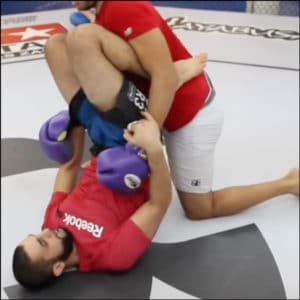
In the distance between the Closed Guard and the Long Range Open Guard Firaz uses one of my personal favourites: Feet on Hips and Knees in Shoulders.
This position allows you to monitor the distance with your feet and block his biceps with your knees and shins. Essentially you’re creating a double bicep control (or inside control) with your feet.
He can try punching you from here, but until he clears your legs his upper arms are just going to thud painfully into your shins and knees again and again.
In addition this position often gives you a chance to control your opponent’s hands/wrists, which gives you an even greater level of safety.
One of the keys here is to lift your hips up off the ground! Experiment with a partner and see what happens if your hips are flat on the floor – most likely you’ll find that he can still punch you. But when you lift your hips up you increase the distance between your face and his fists, which will help your potential modelling career for sure!
For more on range management from the guard check out the footage below (it’s from a 6 week BJJ self defense crash course I taught). In it we cover the specific techniques to keep your opponent far away or really close, as well as the concept about the dangerous middle distance. Check it out if you’re interested…
[youtube width=”480″ height=”360″]https://www.youtube.com/watch?v=4NM7qggkxs0[/youtube]Closed Guard
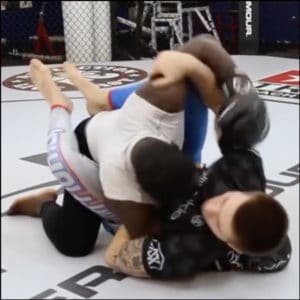 OK, finally we got to it: the classic BJJ Closed Guard position…
OK, finally we got to it: the classic BJJ Closed Guard position…
The Closed Guard was used intermittently by our intrepid grappling experts in the video to not get hit and to set up their own attacks.
In the Closed Guard you control your opponent’s torso with your legs. Typically your ankles are crossed unless you’re in the middle of setting up a sweep or an attack.
It’s almost impossible for your opponent to pass your guard unless he forces open your legs first.
But not having your guard passed is only half the game.
The other thing you’ve got to do is not get your teeth punched down your throat!
If you lose control and your opponent sits up in the closed guard you’re in trouble; all he needs is to land one big punch and your day starts going downhill in a hurry…
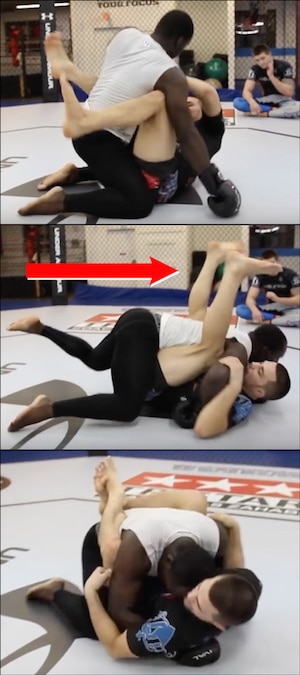 The first thing is to tie up his upper body.
The first thing is to tie up his upper body.
In the video the grapplers are always blocking and checking punches, wrapping up arms with overhooks, and keeping their opponent’s heads down with their own grips from the Closed Guard.
Yes, there are specific grips and techniques you can use, but like so many things we’re talking about today these skills are best learned by actually practising them under pressure (I’ll cover how to do this towards the end of the article).
Just like your arms can pull him forward and off balance, you can do exactly the same thing using your legs…
On the right you can see one example, early in the video, where Garry Tonon disrupted his opponent’s posture by kicking his legs up and bringing his knees towards his chest.
His knees struck his opponent in the back of the armpits and collapsed him forward, allowing Garry to quickly re-establish upper body control.
You can do the exact same thing if your ankles are still crossed behind your opponent’s back…
Breaking posture and controlling grips is a good idea for all of BJJ, but especially in MMA and self defense. Fight, fight, fight to keep your opponent’s arms tied up and his posture broken.
If he does manage to free his arms and sit up then it’s an emergency: you’ve got to move to safety right now, typically to the Feet on Hips and Knees in Shoulders position!
If you want a quick introduction to the BJJ Closed Guard position check out the short video below. You can see the knees-to-chest posture collapsing action at about the 1 minute mark.
[youtube]https://www.youtube.com/watch?v=KKxD5kdOkk0[/youtube]Half Guard
In the Half Guard you have one of your legs in between your opponent’s legs.
In sport BJJ there are many powerful variations of Half Guard (click here to see a few of them).
There are a few exceptions, but you generally DON’T see lot of people playing Half Guard offensively in MMA.
That’s mostly because it’s harder to maintain the minimum safe distance to avoid punches, forearms and elbow strikes.
If you’re using Half Guard and the strikes are flying then you really have to rely on your upper body clinching skills to keep him under control and in a position advantageous to you.
If you let him posture up, or – alternately – flatten you out in an MMA or self defense situation then you’re probably going to be in a world of hurt!
Gordon Ryan starts out using the Half Guard a few times in the experiment’s sparring sessions, but he is very careful to maintain excellent control and quickly manages to sweep his opponent every time, thus taking no damage.
This all being said, Half Guard isn’t an ideal MMA or self defense position but you do need to know what to do should you get caught in there. You still need some answers for how to attack, sweep and transition from Half Guard, it’s just not going to be your ideal number one option to start from!
de la Riva Guard
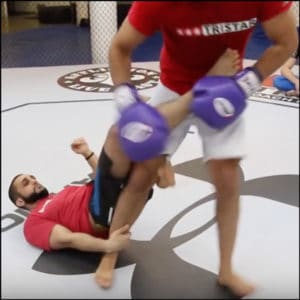 I was thrilled to see the de la Riva guard appear momentarily in the sparring sessions we’ve been breaking down!
I was thrilled to see the de la Riva guard appear momentarily in the sparring sessions we’ve been breaking down!
(Firaz used it to control the distance, and then immediately started working to take the back.)
The reason I was so happy to see it is because it belies all those people who say, “That position would NEVER work in no gi…”
Or even, “I train jiu-jitsu for the street, not for sport competition...”
Yes, the de la Riva guard has been developed to an incredible extent in sport jiu-jitsu, and there are some variations of it that rely very heavily on gi grips.
But any training is good training. Any type of guardwork helps improve your leg dexterity, agility and reaction time.
And there are lots of ways to adapt almost every position that originate in the gi to a no-gi situation (the main exceptions probably being Spider Guard and Worm Guard).
If you have half a brain and have done a modicum of training then you’re not going to be reaching for non-existent lapels in a self defense or MMA situation. Instead you’ll be adapting and improvising exactly the way that the three grapplers in this video did.
Submissions Used in the BJJ Self Defense Experiment
Most of the matches in the experiment between the MMA fighters and grapplers ended in submission. And what was the most common submission? Hands down it was the Heel Hook!
The Heel Hook for Self Defense
The Heel Hook, this one single submission, accounted for just under half of ALL submissions applied during the experiment…
Why did this one submission show up again and again and again?
In part it was because all three experts are really, really skilled at the Heel Hook (Garry Tonon, in particular, is feared for his relentless lower body attacks in competition).
But these guys are good at all aspects of jiu-jitsu, so that fact doesn’t completely explain why this one particular leglock was so powerful…
It seems like once the gi comes off that submissions tend to gravitate towards the legs and the neck. Take a look at modern no-gi competition, old-school catch wrestling, and Brazilian Luta Livre back in the day: they all are no gi grappling arts and all had great chokes and great leglocks!
Another aspect of the Heel Hook that makes it so powerful for self defense is that it doesn’t require much strength. In this submission you’re attacking the relatively small ligaments in his knee and ankle, and he can’t really use strength to muscle out of the submission.
If you have to apply this submission in anger you use the relatively big muscles of your torso against the much smaller ligaments, which is usually accompanied by a loud popping sound and your unfortunate opponent dry heaving on the floor.
(That makes the Heel Hook one of the biggest equalisers you can use if you’re fighting someone much bigger than you.)
Also it keeps you safer from strikes. An opponent who knows that you’re hunting for a Heel Hook is usually going to be pre-occupied with defending this submission. Unless he’s an idiot he knows that he’s close to tapping out; he’ll be trying to escape and won’t be concentrating on breaking your nose.
In addition to him being distracted your legs are also in a great position to disrupt his base. If he’s on his butt and you’re entangling his legs correctly then it’s hard for him to stand up.
And if he does stand up then you can still tap him out standing (I saw this the first time when Marco Ruas tapped out the gigantic Paul Varelens in UFC 7). Or you can go to a Single Leg X Guard style game, sweep him and bring him back down to the ground.
It’s important to recognise that not every leglock entanglement leads to a leglock submission. Sometimes the entanglement is used to sweep the opponent, or as a precursor to standing up and passing the guard. More on this later…
What’s the most common Heel Hook setup used by our three valiant grapplers? Let’s take at a very popular entry used by Garry Tonon. He did it a lot of times so I’m able to show you two different examples from different angles…
As you can see above, the four basic steps are:
- Maintain open guard with at least one foot on the hip
- Get control of one heel and kick the same side leg through your opponent’s legs
- Bring your kicking leg back and around the leg you’re going to attack
- Solidify the basic leglock position.
From that final basic leglock position you can now keep your opponent at a safe distance, sweep him, or tap him out.
Here’s what a similar attack looks like from the opposite side…
Once again the 4 steps are:
- Maintain open guard with at least one foot on the hip
- Get control of one heel and kick the same side leg through your opponent’s legs
- Bring your kicking leg back and around the leg you’re going to attack
- Solidify the basic leglock position.
BEFORE WE GO ON TO THE OTHER TECHNIQUES I’VE GOT SOMETHING SUPER IMPORTANT TO SAY!
(Yes, I know I’m yelling. It’s on purpose.)
Lissen’ up: Heel Hooks are no joke!!!
If you screw up with this move, or if you don’t know what you’re doing, or if you don’t use restraint you WILL destroy the knees of your training partners. Same goes for them hurting you.
You’ll notice in the video how nobody – not Firaz, not Garry, not Gordon – cranked this lock tight.
They all just held the position and their opponent tapped out. Top and bottom player recognised the career-ending potential of this submission.
The Heel Hook requires very little force to do damage. And, worst of all, the damage usually happens before your training partner feels the pain, especially if there’s a bit of adrenaline and testosterone in the room.
If you’re rolling with someone really stubborn and you catch them in this position DO NOT CRANK IT. It doesn’t matter if he’s a douchebag and won’t tap. It doesn’t matter if he tries to escape. It doesn’t matter if he’s gonna squish you into the mat unless you tap him out. If he gets hurt in training it’s YOUR fault.
(Similarly if you get caught in a Heel Hook just tap out. It’s soooo much better than going through ACL reconstructive surgery!)
Here’s a link to an article I wrote about how to train the more dangerous submissions. If you’re going to play Heel Hooks then I think you have to read this and be doing all the stuff it mentions.
The Other Submissions…
Firaz, Garry and Gordon didn’t only rely on Heel Hooks to finish their matches. In fact they used quite the variety of submissions…
The Armbar, Triangle Choke, Straight Footlock (Achilles lock), Guillotine Choke, D’Arce (aka No Gi Brabo) Choke, Rear Naked Choke, and Arm Crush all made an appearance.
What’s interesting to me is that there was only one or two armbars. When you consider how much ‘regular BJJ’ focuses on the armbar this move then seems highly under-represented in these matches.
I think it’s what I alluded to above: when the gi comes off and everything gets slippery then the submissions tend to focus on those body parts that have natural ‘stoppers.’ In practice that mostly means chokes and leglocks.
If you’re on the neck of an opponent then the chin stops you from sliding over the head. And if you’re applying a Footlock or a Heel Hook then the ankle – the narrowest point of the foot – forms a natural control point to hang onto.
Maybe that’s why modern no-gi grappling, catch wrestling and Luta Livre all focus on the neck and the leg…
Sweeps
In addition to submissions during the experiment we also saw Firaz, Garry and Gordon using a lot of sweeps.
Close to the beginning of the article I said that the laws of physics are against you when you’re on the bottom in a self defense or MMA context.
When you’re on the bottom your opponent has gravity on his side, which gives him the ability to deliver powerful punches downward. And to make matters worse, you can’t move backwards to nullify the power of a strike that does land successfully. Instead your head gets a double impact: once from the fist, another as it ricochets off the ground afterwards.
So the ability to sweep someone and get off the bottom is an absolutely essential BJJ self defense skill!
When you watch the experiment you’ll note that many of the sweeps (and submissions also) start with the grappler on bottom grabbing the heel of his standing opponent.
This is a really important first step…
When your opponent is detached from you he can move around. As soon as you establish and maintain contact with your opponent you can move him around and respond to his movements MUCH easier (which is why it was the first recommendation in my article about dealing with standing opponents in BJJ).
Once that first point of contact is made things will evolve differently, depending both on what your plan is and what your opponent tries to do.
There were three sweeps that showed up repeatedly in the MMA-BJJ experiment video. Let’s look at all three…
Sweep #1 – the Tripod Sweep
It’s an oldie but a goodie. Here is but one example of it being used as part of the strike defense plan by Gordon Ryan…
The four steps of the Tripod Sweep are:
- Start with at least one foot on the hip
- Control the ankle of one leg with your hand
- Hook the opposite leg with your instep (at the knee or behind the foot)
- Push on the stomach and pull with your arm and other foot to knock your opponent over.
From here you’re typically going to use the Technical Standup to get up and start pass the guard, or stay on the ground and go to your leglock game.
The funny thing is that you probably learned the Tripod Sweep in your first few weeks of jiu-jitsu. And now here are three world class grapplers using that very same technique!
The use of this ‘basic’ technique is a great illustration of how often the K.I.S.S. principle applies: Keep It Simple Stupid! This is especially true when you’re under pressure (i.e. facing the very real possibility of getting blasted in the face) and when you don’t have a lapel to wrap three times around your opponent’s leg.
From the Guard Sweeps mobile app here’s a quick video breakdown of the Tripod sweep, including some additional tips and tricks to make the move easier…
[youtube]https://www.youtube.com/watch?v=1p-2qBPL9tM[/youtube]Sweep #2 – the Butterfly Sweep
The Tripod Sweep wasn’t the only classical BJJ sweep to make an appearance in this ground and pound experiment.
The Butterfly Sweep was also used more than once, both from the formal butterfly guard and also from a hybrid half guard position.
This makes sense, because the Butterfly Guard is one of the most powerful ways to sweep an opponent when he’s on his knees.
And the Butterfly Guard isn’t overly reliant upon gi grips, which makes it a very popular choice for many modern no-gi competitors.
The Butterfly Sweep technique is the workhorse of the Butterfly Guard. Watch high level players compete and they’ll hit it again and again against people who know it’s coming.
For a crash course in just this one move watch the video below…
[youtube]https://www.youtube.com/watch?v=3aH8aNK08ds[/youtube]Sweep #3 – Leglock Attacks Turning Into Sweeps
Another common way that the grappler on bottom made his way to the top was through the use of a leglock.
This can occur in one of two ways…
- Intentionally.
- Reactively.
Intentional leglock to sweep conversions happen when the bottom man wants to get to the top. He might set up a leglock and use it like a Single Leg X Guard to sweep his opponent. The threat of the leglock – especially the Heel Hook – makes the sweep even easier to accomplish!
But sometimes your opponent takes matters into his own hands and you have to use the sweep as a reaction to something your opponent did…
In the photo sequence below Garry’s opponent tries to roll out of an implied Heel Hook attack. It’s not a bad response, but Garry knows this is coming, follows him with a roll of his own, and then immediately gets to his feet into a strong passing position.
Knowing how to transition between leglocks, sweeps and guard passes is an important skill to have. It is developed by spending enough hours on the mat to be able to predict the most likely reactions you’ll encounter from your opponent.
How to Train for BJJ Self Defense
Yes, BJJ is a fantastic sport and fitness activity, but it’s also a martial art. And that means that you need to be able to use it to defend yourself.
But the good news is that you DON’T need to devote all your training to ‘reality’ self defense.
In fact, you’re doing most of the heavy lifting just with your regular BJJ training. You are, to some extent, training your self defense skills every day that you spar against resisting opponents, struggle to escape from the bottom and fight to pass the guard even if you never throw a single punch.
That’s because you’re learning to apply your techniques under pressure and against resistance (unlike all those overweight combative experts who could never apply their nerve strikes and eye gouges against a real opponent if their lives depended on it).
And if you compete then you’re getting even better at dealing with high pressure situations.
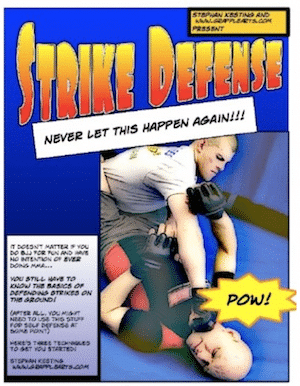 That being said, you can’t be secure in your self defense skills if completely forget about this aspect of the art.
That being said, you can’t be secure in your self defense skills if completely forget about this aspect of the art.
So practice headlock defences once in a while.
Read my 9 Rules for BJJ self defense.
Study how to defend strikes from different BJJ positions.
And, most importantly, try doing what Firaz, Garry and Gordon did a few times a year. Put in a mouthguard, have someone put on the big 16 oz gloves and let them tee off on your face.
Pick your partners carefully of course.
Avoid newbies who don’t understand the difference between training and fighting. Don’t use MMA gloves unless you really trust the guy. And don’t do this with some steroid-soaked wild man who has major anger management issues.
But this type of live training with the right people can be a lot of fun! You learn a lot in a hurry! A little bit of practice once in a while defending against punches without the gi helps recalibrate your jiu-jitsu for the streets.
There’s nothing that helps you learn quite as fast as the occasional punch in the face!
Acknowledgements
Thanks to Firaz Zahabi, Garry Tonon, Gordon Ryan, and their opponents for helping produce this very educational piece of content!
The post The BJJ Self Defense Experiment appeared first on Grapplearts.

